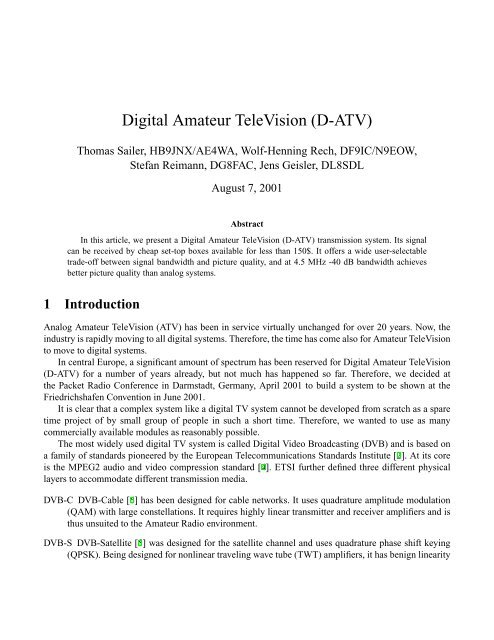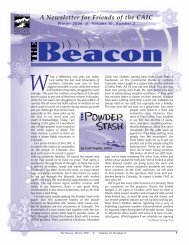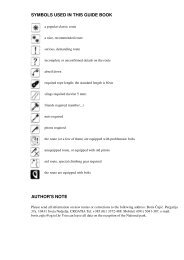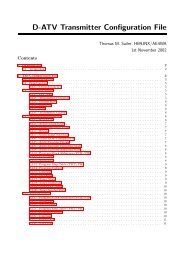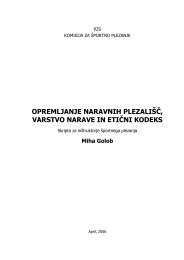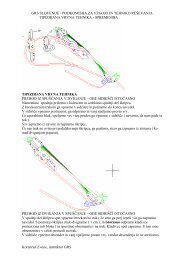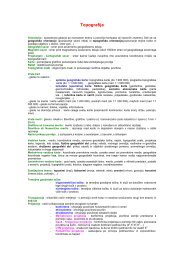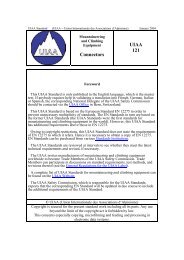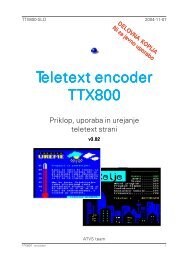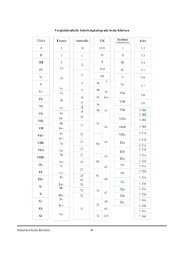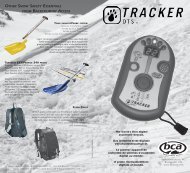Digital Amateur TeleVision (D-ATV) - Bavarian Packet Radio Group
Digital Amateur TeleVision (D-ATV) - Bavarian Packet Radio Group
Digital Amateur TeleVision (D-ATV) - Bavarian Packet Radio Group
You also want an ePaper? Increase the reach of your titles
YUMPU automatically turns print PDFs into web optimized ePapers that Google loves.
2.2 The Base Band ProcessorFigure 2: The Fujitsu MPEG2 Encoder EvaluationBoardFigure 3: The Base Band Processor FPGA Boardwith D/A Converter Daughter Board2.2 The Base Band ProcessorFigure 4 depicts the functions performed by the DVB-S Base Band Processor. The first row of blocksoperate on bytes, while the lower two blocks operate on bits.First, the signal source, either the external MPEG2 encoder or the internal Test Data Source is selectedby a jumper. The Test Data Source helped integration.The Framing block extracts framing signals from the transport data stream and synchronizes the othermodem blocks.The Pseudo-Random Byte Sequence (PRBS) generator scrambles the data stream with a pseudorandomsignal to ensure an adequate number of transitions in the signal.The outer error correction encoder uses a Reed Solomon RS(255,239,8) code shortened toRS(204,188,8). The RS encoder operates in GF(2 8 ), that is on bytes. It takes an input block of 188 bytes (aMPEG2 transport stream packet) and adds 16 redundant bytes that help the receiver correct transmissionerrors.The interleaver reorders the data stream. Its main purpose is to spread burst errors over multiple codewords (that is 204 byte Reed-Solomon blocks).The Parallel to Serial block converts the byte stream into a bit stream, which is then fed to the innerencoder, a Convolutional Encoder. The Convolutional Encoder produces two bits for every input bit.
2 THE D-<strong>ATV</strong> TRANSMITTERPuncturing can then be used to throw away some of the generated redundant bits. The overall code rate isselectable by jumpers to be 1 2 , 2 3 , 3 4 , 5 6 or 7 8, to accommodate different data rate and error resilience needs.The QPSK Signal Mapper then generates the QPSK signal from the Puncturing output and feeds it intotwo 4 times oversampling Raised-Cosine filters.The whole Base Band Processor was implemented in a Xilinx Spartan2 XC2S200 device. We usedthe B3-SPARTAN2+ FPGA Board from Burch Electronic Design [1]. The device is about 10% full andachieves more than 80 MHz clock rate. This results in a symbol rate of up to 20 MSymbols/s. Figure 3depicts the FPGA Board together with the D/A Converter Daughter Board.We plan to increase the maximum symbol rate in the future. The current design has two speed bottlenecks.The oversampling filters may be sped up by changing the architecture. The Reed-Solomon encodertakes 16 clock cycles to encode a single byte, because it uses only one Galois Field Multiply Accumulate(GFMAC) units. It can trivially be accelerated by using multiple GFMAC units.TSTest DataSourceFramingPRBSRS EncoderRAMInterleaverPuncturingConvolutionalEncoderParallel toSerialQPSK SignalMapperRC OversamplingFilterRC OversamplingFilterFigure 4: The DVB-S Baseband Processor
Figure 7: The Complete DVB-S Transmitter demoed at the Friedrichshafen Ham FairSince the Xilinx FPGA device is now only about 10% full, there are numerous extensions possible,such as• multiplexing several sources onto the same carrier• increasing the maximum symbol rate of the base band processor• filling unused MPEG2 transport frames with network data, such as AX.25 or TCP/IP traffic
REFERENCESReferences[1] Burch Electronic Design. http://www.BurchED.com.au.[2] European Telecommunications Standards Institute (ETSI). http://www.etsi.org.[3] SR Systems. http://www.sr-systems.de.[4] ISO/IEC 13818-1 Generic Coding of Moving Pictures and Associated Audio: SystemsRecommendation H.222.0, 04 1995.[5] ETSI EN 300 421 V1.1.2 <strong>Digital</strong> Video Broadcasting (DVB); Framing structure, channel coding andmodulation for 11/12 GHz satellite services (DVB-S), 08 1997.[6] ETSI EN 300 429 V1.2.1 <strong>Digital</strong> Video Broadcasting (DVB); Framing structure, channel coding andmodulation for cable systems (DVB-C), 04 1998.[7] ETSI EN 300 744 V1.4.1 <strong>Digital</strong> Video Broadcasting (DVB); Framing structure, channel coding andmodulation for digital terrestrial television (DVB-T), 01 2001.[8] Matjaz Vidmar. DUBUS Technik-Buch V, chapter No-Tune SSB Transceivers for 1.3, 2.3 , 5.7 and 10GHz, pages 203–291. DUBUS, 1995–1997.


